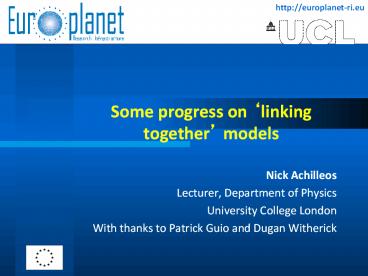Some progress on
Title: Some progress on
1
Some progress on linking together models
- Nick Achilleos
- Lecturer, Department of Physics
- University College London
- With thanks to Patrick Guio and Dugan Witherick
2
- Report from UCL
- We have been pursuing activities which may
produce some useful demonstrators and
deliverables for the JRA3 Distributed Modelling
Laboratory. - Modelling auroral dynamics at Jupiter (PhD
project by J. N. Yates) - Coupling UCL Jovian magnetodisc model with a
model of plasma flow (Achilleos, Guio) - Other possibilities ?
3
Auroral Dynamics at Jupiter
- Model 1
- - The UCL global, axisymmetric model of Jupiters
thermosphere and ionosphere (e.g. Smith and
Aylward, Ann. Geo., 2009). - Solves equations of fluid flow for the neutral
thermosphere. - Needs an algorithm for computing ionospheric
current, esp. in the auroral region. - Uses Model 2 the theoretical profile by Grodent
and Gerard (JGR 2001) for auroral ionosphere
(ion density versus altitude)
4
Model Linkage
- Architecture Auroral profile is built into a
subroutine of UCL code
UCL model reads auroral profile as a template
for auroral ionosphere
The ion density profile is scaled at all
altitudes by the same factor, according to the
conductance properties calculated by the disc
dynamics routine - gives plasma rotation rate and
corresponding M-I currents.
5
- For more information, see paper submitted to PSS
by Yates, Achilleos and Guio (2010, arxiv) - Grodent / Gerard profile (ascii files?) may be
added to JRA3 Catalogue - We need more 1D theoretical profiles of auroral
structure so that we may use the UCL Jovian and
Kronian models as a testbed - this should be
emphasised as a useful goal of the DNML. - Note also the work of Nicholson et al (MNRAS
2009) on precipitation at Mars, UCL are working
on taking this further to a coupled model of
Martian thermosphere and aurora.
6
Giant Planet Magnetospheres
- Example 1 UCL Magnetodisc model
- What is it ? A model which calculates
self-consistent magnetic field structure and
plasma distributions for a disc-like,
axisymmetric, rotating magnetosphere. Used for
studies of magnetospheric structure at Saturn and
Jupiter (giant rapid rotators) e.g. Achilleos,
Guio and Arridge (MNRAS, 2010), Achilleos et al
(GRL, 2010)
7
- Present disc model assumes a fixed profile of
plasma rotation (angular velocity ?M) versus
radial distance. - New configuration couples disc B-field model to
an independent solver of plasma ?M
B Field Profile in Plasmadisc
?M Solver
UCL Magnetodisc Model
?M profile needed to update force balance,
re-compute B Field
8
- New configuration links two independent Matlab
codes on different nodes in a local network
through a simple Java class using IP Sockets. - We could do a similar exercise for the
magnetopause field model - at present we use
average value from the formulae of Alexeev et al
(Ann. Geo. 2005) (Catalogue entry ?)
B Field Profile in Plasmadisc
?M Solver
UCL Magnetodisc Model
?M profile needed to update force balance,
re-compute B Field
9
- A reminder of what JRA3 activities may foster in
the long term - My feeling is that these are beyond the scope of
Europlanet (not enough resource) but they may
indicate where we are headed if we follow some
of the more simple ideas. - Example A A time-dependent MHD model of Jovian
or Kronian plasmadisc to couple to the
appropriate atmospheric GCMs, to study transient
auroral response. - Example B A time- and space-dependent model of
auroral precipitation associated with the
Io-Jupiter current circuit, to investigate the
nature of wind systems driven by such a localised
source of auroral energy input.
10
- Progress on Catalogue-Linked Web Apps
- These are
- The H3 cooling function calculator (code from S.
Miller) JRA3T3 - The VoiSe image segmentation tool (code from P.
Guio) JRA3T4 - Web apps migrated to new webserver (beginning
2011) and are now live at - http//astroweb.projects.phys.ucl.ac.uk/europlanet
jra3/ - Entries for these web apps have been update on
the JRA3 catalogue.
11
Process diagram for each web app
Process Job
User
Results/Notification by Email
Input files?
Input parameters
Job details
Results?
Queue Job
Validate Parameters
Jobs
Job details
Job details
12
- Technologies used for Web Apps
- Web Interface and Parameter Validation
- Django web framework for Python
- Job Queuing System/Broker
- RabbitMQ Advanced Message Queuing Protocol (AMQP)
compliant message queuing system - Job Processing
- Django-Celery asynchronous task queue/job queue.
- Database for Job Detail Storage
- MySQL
13
- Upcoming Web Apps
- MarTIM
- Mars Thermosphere and Ionosphere Model
- 3D general circulation model of the Martian
middle and upper atmosphere from 0.883 to
9.910-8 Pa. - Developed by Will Nicholson
- Possible coupling to TransMars
- UCL Magnetodisc Model
- Described earlier
- A library of disc model outputs for community use
to be placed in the Catalog.
14
- Next steps?
- Action for all JRA3 Modellers Whose work is
relevant to what you are trying to achieve ? Are
they in the catalog - would they be willing to
have an entry in the catalog ? - The examples shown here illustrate the need in
some areas of planetary science for progress by
coupling models, even at a very basic level -
e.g. GCMs as testbeds for auroral profiles - There may also be a possibility that we could
provide force-balance models for theoretical
models of exoplanet discs (e.g. work by
Khodachenko et al) - Keep it simple, keep it realistic, make it a part
of what you would naturally want to do in your
own research programme - From our meetings, it is clearer that IDIS
ideally would provide a variety of databases
which, in principle, could be queried from a
system like the one described herein - keep this
in mind, and keep informed of IDIS progress.
(Note IDIS general meeting in Rome, June 7)































